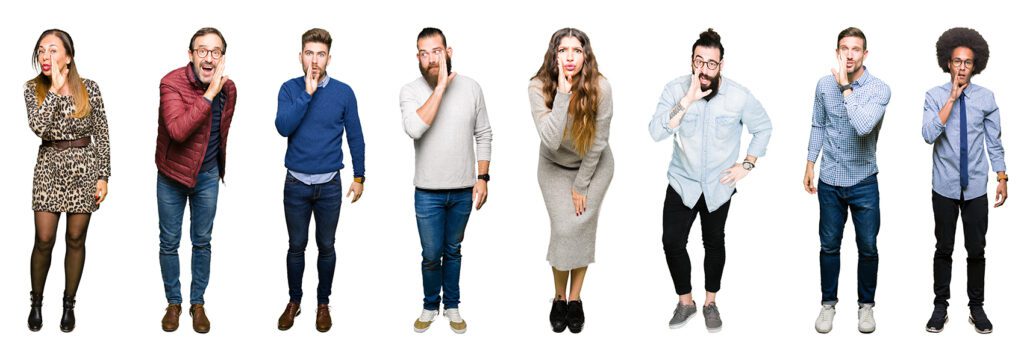If you were born after 2000, you may not be familiar with word-of-mouth marketing.
Suffice it to say that word-of-mouth was a hot topic in the early 2000’s.
According to referral marketing firm Extole, the term is attributed to psychologist George Silverman in the early 1970s. Silverman referred to word-of-mouth (WOM for short) as “teleconferenced peer influence groups”.
A simpler definition: WOM refers to users or fans of a product or service sharing what they like about it. Or don’t. It doesn’t cost a cent….unless you’re paying influencers on social media. And it’s a marketing tool every business should be using.
In their 2003 book, Creating Customer Evangelists, Jackie Huba and Ben McConnell call these happy fans “evangelists”. Here’s an excerpt from MarketingProfs.
In his 2006 book, Word of Mouth Marketing: How Smart Companies Get People Talking, Andy Sernovitz talks about “honest marketing”. Your fans do the work for you, spreading the word about how great your product is. It’s authentic.
And my personal favorite, Emanuel Rosen’s The Anatomy of Buzz published in 2002. Buzz is the “word-of-mouth magic” that happens when consumers are persuaded by recommendations by friends. Note: a revised copy was published in 2009.
Fast forward to 2022 and a recent Orbit Media Wine & Webinar featuring Jared Spool. His presentation was titled “That One Weird Trick That Makes Marketing Soooo Much Easier”.
Keyword: influencers.
The trick? Using word-of-mouth to turn customers into influencers.
Suggestion: go sign up for Orbit’s Wine & Webinars if you want to stay informed and entertained.
Back to Jared Spool. An author, consultant, speaker and UX (user experience) expert. His job description is “Maker of Awesomeness”. And awesomeness is what he says marketers need to focus on.
Spool suggests that people are so busy with social media that word-of-mouth (which falls under the social media banner) gets short shrift.
Ever hear of the Kano Model? I hadn’t til I heard Jared.
The Kano Model is a tool that breaks out the way people respond to a product (or service). It’s a way for you to determine customer satisfaction based on three criteria.
The first criteria is Basic Expectations. As the term suggests, these are features your target market expects. If you’re buying a house, you expect a certain number of rooms, maybe a garage and basic amenities.
Criteria #2 is Performance Features. These are the satisfiers. For the house you’re buying, central air conditioning and nice landscaping aren’t necessary (basic) but they’re attractive.
Criteria #3 is Excitement Features. And these are just that – exciting. They elicit WOW! reactions and delight the user. In your house hunt, a glam marble bathroom with a jacuzzi, soaking tub, heated floors and a big walk-in shower fall into this category.
Delight, The Ultimate Tool
The goal is to “enhance performance and increase customer satisfaction with features your customers will be delighted with”. Survey Monkey does a good job of explaining how it works.
A Positive User Experience (UX)
Whether you call it UX (user experience) or CX (customer experience), it’s basically the same.
- Figure out how to delight your customers.
- Make their lives better.
- Solve a gnawing problem.
- Exceed their expectations (or what Kano calls Basic Expectations).
Happy customers share their experiences. So do unhappy customers but that’s for another post.
Applying the KANO model.
Have you been delighted? Think about the last time you were delighted by a product or service. I
I’ll start. I went into my local hardware store looking for a plant moisture probe. I knew they would have it cause they’re my “go to” neighborhood store and they have above and beyond what most hardware stores have.
This time, however, the product was out of stock. So much for my Basic Expectations.
But this store knows how to exceed expectations. The salesperson headed over to the computer, located the product I needed, ordered it for me and told me they’d send a text when it was in. An hour later, I had a text telling me it would be in next Thursday for me to pick up.
On Wednesday, I got a phone call saying it was in the store and I could pick it up. Promise a customer something. Then exceed that promise.
According to the KANO model, this store’s service is above and beyond a basic expectation. So of course, I’ve already told more than a few people that it’s the best hardware store I’ve ever been to.
That said, the same word-of-mouth also works to hurt your company if you fail to satisfy a customer’s basic expectation.
The customer who goes into that hot new Italian restaurant and has bad service and/or cold food will share that bad experience with anyone who asks how it was.
A bad experience spreads like wildfire on social media. Think of all the restaurants that closed during COVID. The ones that were able to keep customers happy survived. The ones that didn’t have enough staff closed. And the internet became more important than ever for sharing experiences. And for cheerleading.
If you’re not currently using word-of-mouth marketing, add it to your marketing plan for 2023.
Related Blog Posts
How to deliver a remarkable customer experience
